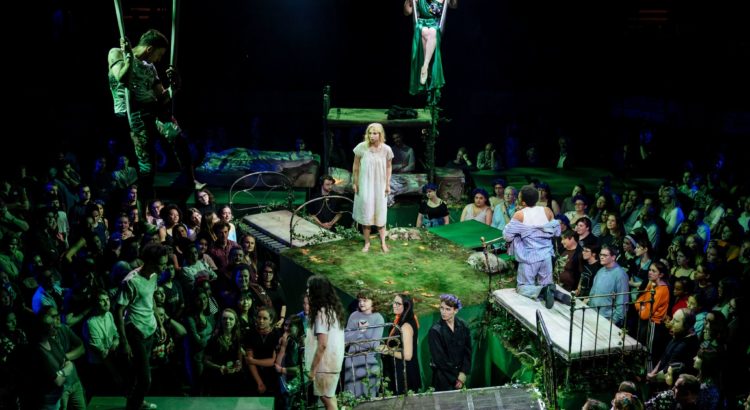Theatre in the round? Kind of. But, like, more than that.
The University Musical Society brought this production of A Midsummer Night’s Dream to the Michigan Theatre as a National Theatre Live streaming on Sunday, November 24.
Director Nicholas Hytner’s take on the classic is comical, enchanting, and the most entertaining Shakespeare I have seen performed. During an intermission interview Hytner stated he began work on the play with some very strong ideas. First was the use of silks and aerial performance, as well as modeling the world of Athens after that of Gilead in The Handmaid’s Tale to reinforce the contrast between the repressive culture of the city and the freedom of the forest. The most effective directorial decision made by Hytner was to switch many of Titania and Oberon’s lines, changing the usual plot so that Titania is the one to trick Oberon, instead of the other way around.
In addition to his role as director of this production Hytner is also the co-founder of Bridge Theatre, a new 900-seat performance venue in London designed with a high degree of adaptability. As director he takes great advantage of this unique space to create the magical world of the forest. Production designer Bunny Christie uses this canvas masterfully as platforms are raised, lowered, and shifted through a standing audience to create an immersive and magical world. Beds that signify actual sleeping quarters in Athens return festooned with moss, vines, and leaves to represent the trees and landscape of the forest. The fairies’ domain is made of flying aerial silks which the actors use to great effect, spinning, twisting, and posing to illustrate their prowess in magic and spellcasting.

The lighting design of Bruno Poet and sound design of Paul Arditti both work with the scenic design to create a wonderful sense of atmosphere. While the lighting in Athens is stark and monochromatic, it shifts to deep greens and ethereal purples once the story shifts to the forest. Poet also does a great job of creating focus on specific areas. While holding Titania in a spotlight, a burst of light reveals Puck, having sprung up on the opposite platform. Arditti’s well-chosen sound combines with these lighting effects to create an almost tangible magic in the air, reinforcing the omnipresent nature of the mischievous fae. His atmospheric soundscape is near perfect. The best sound atmosphere is one that goes unnoticed. It is felt but never inserts itself into the scene. The low synth chords of Athens and the lilting strings of the forest do just that. They imbue the audience with a feeling that not only fits the words of the playwright but also justify the other design elements.

Christina Cunningham’s designs also reinforce the director’s visions. The stark and simplistic grey dresses of the Helena and Hermia in the city, combined with their white head coverings produce a broadly dystopian impression. The plain black suits of Theseus, Egeus, Demetrius, and Lysander are a uniform of masculine power. It is in these elements that Hytner’s inspiration from The Handmaid’s Tale is most evident. The Rude Mechanicals are costumed in jumpsuits, highly reminiscent of the party uniform of Orwell’s Nineteen Eighty-Four. However, the most striking Athenian costume is Gwendoline Christie’s first as Hippolyta. Her black gown is beautiful in its simplicity and powerful in its monastic silhouette. She is striking, posed as a stark statue in a glass cage, placed there by Theseus. The costumes of the forest characters present a more fun, whimsical image. Puck flits in and out of scenes in patchwork jeans, graphic tank, and colorful armbands. The other fairies have faces painted with glitter and look more like acrobats or fashion models than beings of nature. Oberon, cast by Hytner as a frivolous playboy, is perfectly gorgeous for most of the play in long flowing gold silk robe, often shirtless underneath.
The one pitfall in the costume design is Christie’s green gown as Titania. This dress is emerald green, silky, more than floor-length, and one-shouldered. The asymmetrical floral detail on the bust contributes to a hyper-feminine and soft picture. This picture directly contrasts the headstrong, vengeful Queen that arises with Hytner’s line arrangements. What would make sense in a traditional rendering of Midsummer just doesn’t work here.
The sheer amount of talent, wit, comedy, and spectacle in this show had me thinking back to it constantly. It made me glad to have seen it and glad to be studying theatre. If there’s one major objection I have, it’s that there’s almost too many ideas in this production. The audience participation and reaction is a riot to watch, the aerial work is amazing, the acting top-notch, and the designs gorgeous. But I at times felt lost in the concept of it. While likening Athens to the theocracy of Gilead creates a striking stage picture, the extremely heavy real-world consequences of that dystopia doesn’t seem to fit in the comedic, self-aware romp of the rest of the production. The aerial acrobatics are well-integrated until Gwendoline Christie spends her time as Titania just sitting on a silk, buckled in, drawing attention to the fact that she is not an aerial artist. The comedy is refreshing until the Rude Mechanicals’ performance near the end is so drawn out that people are checking their watches.
But don’t get me wrong- this is a fantastic production. I haven’t read Midsummer for years and my memory of the plot was fuzzy, so this was a refreshing dip back into the story. And there’s so much more I could write about. Before this my favorite Shakespeare play was Twelfth Night, but Puck may have just bewitched me into changing my mind.




